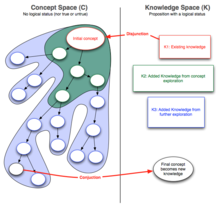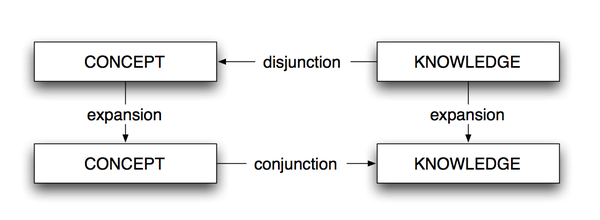
C-K design theory or concept-knowledge theory is both a design theory and a theory of reasoning in design. It defines design reasoning as a logic of expansion processes, i.e. a logic that organizes the generation of unknown objects. The theory builds on several traditions of design theory, including systematic design, axiomatic design, creativity theories, general and formal design theories.[1]
YouTube Encyclopedic
-
1/1Views:773
-
YBETV Presents: Good D*ck, Bad D*ck Theory Part 2 (Decoded)
Transcription
Background
Claims made for C-K design theory include that it is the first design theory that:
- Offers a comprehensive formalization of design that is independent of any design domain or object
- Explains invention, creation, and discovery within the same framework as design processes.
The name of the theory is based on its central premises: the distinction between two spaces:
- a space of concepts C
- a space of knowledge K.
The process of design is defined as a double expansion of the C and K spaces through the application of four types of operators: C→C, C→K, K→C, K→K.[2]
The first draft of C-K theory was sketched[3] by Armand Hatchuel, and then developed by Hatchuel and his colleague, Benoît Weil.[4] Recent publications explain C-K theory and its practical application in different industries.[5]
Genesis of C-K theory
C-K theory was a response to three perceived limitations of existing design theories:[6]
- Design theory when assimilated to problem solving theory is unable to account for innovative aspects of design.
- Classic design theories dependent on object domains, machine design, architecture or industrial design favored design theories that were tailored to their specific knowledge bases and contexts. Without a unified design theory these fields experience difficulties over cooperation in real design situations.
- Design theories and creativity theories have been developed as separate fields of research. But design theory should include the creative, surprising and serendipitous aspects of design; while creativity theories have been unable to account for intentional inventive processes common in design fields.[7]
C-K theory uses an approach which is domain-independent and which allows acting on unknown objects, and changes of the definitions of known objects during the process (revision of objects' identities).[8] C-K theory was shown by Hatchuel and Weil[8] to be closely related to Braha's Formal Design Theory[1] and its clarification by Braha and Reich's Coupled Design Theory,[9] which are both based on topological structures for design modeling.
Structure of C-K theory
The core idea behind C-K theory is to define rigorously a design situation. A brief is an incomplete description of objects that do not exist yet and are still partly unknown.[10] The first step in C-K theory is to define a brief as a concept, through the introduction of a formal distinction between concept and knowledge spaces; the second step is to characterize the operators that are needed between these two spaces.
Knowledge
The knowledge space is defined as a set of propositions with a logical status, according to the knowledge available to the designer or the group of designers. The knowledge space (i.e. K-Space) describes all objects and truths that are established from the point of view of the designer. Then K-Space is expandable as new truths may appear in it as an effect of the design process. Conversely, the structure and properties of the K-Space have a major influence on the process.[8]
Concept
A concept is defined as a proposition without a logical status in the K-Space. A central finding of C-K theory is that concepts are the necessary departure point of a design process. Without concepts, design reduces to standard optimization or problem-solving. Concepts assert the existence of an unknown object that presents some properties desired by the designer. Concepts can be partitioned or included, but not searched nor explored.[8]
C-K operators
Building on these premises, C-K theory shows the design process as the result of four operators: C→K, K→C, C→C, K→K.
- The initial concept is partitioned using propositions from K: K→C
- These partitions add new properties to the concepts and create new concepts: C→C
- Thanks to a conjunction C→K this expansion of C may in return provoke the expansion of the K space: K→K
The process can be synthesized through a design square. One design solution for a first concept C0 will be a path in the C-space that forms a new proposition in K. There may exist several design paths for the same C0.

Central findings
The following graphical representation summarises the design process using C-K theory.

- Crazy concepts
Crazy concepts are concepts that seem absurd as an exploration path in a design process. Both C-K theory and practical applications have shown that crazy concepts can benefit the global design process by adding extra knowledge, not to be used to pursue that "crazy concept" design path, but to be used to further define a more "sensible concept" and lead to its eventual conjunction. The following image is a graphical representation of this process.

- Design creativity
The creative aspect of Design results from two distinct expansions: C-expansions which may be seen as "new ideas", and K-expansions which are necessary to validate these ideas or to expand them towards successful designs.[8]
- Unification of design theories
Domain dependent design theories are built on some specific structure of the K-space, either by assuming that some objects have invariant definitions and properties (like in all engineering fields), or by assuming that the K-space presents some stable structure (e.g. that the functions of an object can be defined independently from its technical realization, as in systematic design theory).
- Theory of design
At The Design Society's 2009 International Conference on Engineering Design, an awarded-paper[11] links scientific discovery and design process using C-K theory as a formal framework. It is suggested that a science of design is possible, and complementary to the more traditional bounded rationality.[12][unbalanced opinion?]
- Mathematical modelling
Mathematical approaches to design have been developed since the 1960s by scholars such as Christopher Alexander, Hiroyuki Yoshikawa, Dan Braha and Yoram Reich. They tended to model the dynamic co-evolution between design solutions and requirements. Within the field of engineering design, C-K theory opens new modelling directions that explore connections with basic issues in logic and mathematics; these are different from the classic use of scientific models in design. It has been argued[13] that C-K theory has analogies with forcing in set theory, and with intuitionistic mathematics.[14]
- Industrial applications
C-K theory has been applied in several industrial contexts since 1998, mainly in France, Sweden and Germany. It is generally used as a method that increases the innovative capacity of design and R&D departments.[unbalanced opinion?][citation needed] C-K theory has also inspired new management principles for collaborative innovation, with the aim of overcoming the limitations of standard design management methods.[15][16]
References
- ^ a b Braha D. and Maimon O. 1998. A Mathematical Theory of Design: Foundations, Algorithms, and Applications. Springer.
- ^ Kazakçı, A.O.; Tsoukias, A. (22 May 2008). "Extending the C–K design theory: A theoretical background for personal design assistants". Journal of Engineering Design. 16 (4): 399–411. doi:10.1080/09544820500131300. ISSN 0954-4828. S2CID 62142059.
- ^ Hatchuel, Armand (1996). Théories et modèles de la conception, Cours d'ingénierie de la conception. Paris: École des Mines de Paris.
- ^ Hatchuel, A; B. Weil (2002). La théorie C-K : Fondements et usages d'une théorie unifiée de la conception (PDF). Colloque Sciences de la conception.
- ^ Hatchuel A., Le Masson P. & Weil B. (2004), C-K Theory in Practice: Lessons from Industrial Applications Archived 20 July 2011 at the Wayback Machine, 8th International Design Conference, D. Marjanovic, (Ed.), Dubrovnik, 18–21 May 2004: 245–257.
- ^ Hatchuel, A and Weil, B 2003, A new approach of innovative design: an introduction to C-K theory Archived 20 July 2011 at the Wayback Machine. Proceedings of the international conference on engineering design (ICED'03), Stockholm, Sweden, pp 109–124
- ^ Hatchuel, Armand, Le Masson, Pascal, and Weil, Benoit. (2008) Studying creative design: the contribution of C-K theory Archived 20 July 2011 at the Wayback Machine. Studying design creativity: Design Science, Computer Science, Cognitive Science and Neuroscience Approaches, Aix-en-Provence, France, 10–11 March 2008
- ^ a b c d e Hatchuel A. and Weil B., C-K design theory: An advanced formulation, Research in Engineering Design, 19(4):181–192, 2009
- ^ Braha D. and Reich Y. 2003. Topological Structures for Modeling Complex Engineering Design Processes. Archived 26 September 2013 at the Wayback Machine Research in Engineering Design 14(4): 185–199.
- ^ Eris, Ozgur (2004). Effective inquiry for innovative engineering design. Kluwer Academic Publishers.
- ^ Shai, O; Reich, Y; Hatchuel, A; and Subrahmanian, E. (2009) Creativity Theories and Scientific Discovery: a Study of C-K Theory and Infused Design. Archived 20 July 2011 at the Wayback Machine, International Conference on Engineering Design, ICED'09, 24–27 August 2009, Stanford CA.
- ^ Hatchuel A. & Weil B. (2002), C-K Theory: Notions and Applications of a Unified Design Theory Archived 20 July 2011 at the Wayback Machine, Proceedings of the Herbert Simon International Conference on " Design Sciences ", Lyon: 22
- ^ Hatchuel, Armand; B. Weil (2007). Design as Forcing: Deepening the foundations of Ck theory (PDF). 16th International Conference on Engineering Design. Archived from the original (PDF) on 20 July 2011. Retrieved 27 May 2010.
{{cite book}}: CS1 maint: location (link) CS1 maint: location missing publisher (link) - ^ Kazakci, Akin, and Hatchuel, Armand,Is "creative subject" of Brouwer a designer? – an Analysis of Intuitionistic Mathematics from the Viewpoint of C-K Design Theory? Archived 20 July 2011 at the Wayback Machine, International Conference on Engineering Design, ICED'09, Stanford CA, 24–27 August 2009.
- ^ Hatchuel, A. ; Le Masson, P. and Weil, B. (2009) Design Theory and Collective Creativity: a Theoretical Framework to Evaluate KCP Process Archived 20 July 2011 at the Wayback Machine. International Conference on Engineering Design, ICED'09, 24–27 August 2009, Stanford CA.
- ^ Elmquist, M. and Segrestin, B. (2009). "Sustainable development through innovative design: lessons from the KCP method experimented with an automotive firm."
